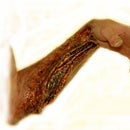Introduction: Free and Dirty Conductive Thread-
Strip insulated wires to harvest the valuable copper "thread" for E-textile projects.
In this I'ble I will show you my method, of stripping insulated waste cable for E-textile projects.
Why pay for expensive conductive thread when there is a cheap and available source at our finger tips.
Todays electronics often leave us with, useless lengths of insulated wire.
The equipment long since dead.
Now re-cycle this cable into a new purpose.
Step 1: Slice Insulation
Take you insulated wire and cut a small slice up the length of the end.
Expose the cluster of threads.
Firmly grasp the wire then peel the insulation back down the length.
If done correctly the insulation should, all come of like a banana skin in one piece.
Step 2: Separating the Strands
You may find the strands are twisted through the length.
Un-twist the length.
Carefully remove individual strands and spool them for future use.
Step 3: Free Conductive Thread!!
This thread can be used for a variety of applications.
It is easy to solder and very flexible. Try not to kink the strand though as it may create a weak spot and break.
Try experimenting with a variety of different rated cables. You will find many sizes of strand depending on you project needs.
For an example of its use see my E-textile RoBot













